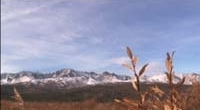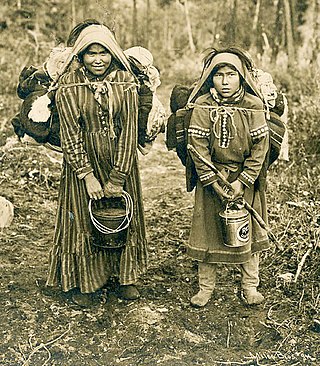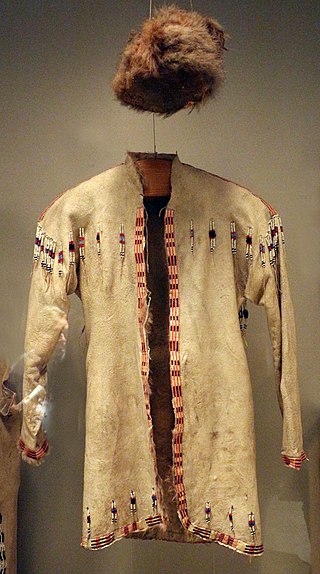Related Research Articles

Interior Alaska is the central region of Alaska's territory, roughly bounded by the Alaska Range to the south and the Brooks Range to the north. It is largely wilderness. Mountains include Denali in the Alaska Range, the Wrangell Mountains, and the Ray Mountains. The native people of the interior are Alaskan Athabaskans. The largest city in the interior is Fairbanks, Alaska's second-largest city, in the Tanana Valley. Other towns include North Pole, just southeast of Fairbanks, Eagle, Tok, Glennallen, Delta Junction, Nenana, Anderson, Healy and Cantwell. The interior region has an estimated population of 113,154.

Tanacross is an endangered Athabaskan language spoken by fewer than 60 people in eastern Interior Alaska.

Athabaskan is a large family of indigenous languages of North America, located in western North America in three areal language groups: Northern, Pacific Coast and Southern. Kari and Potter (2010:10) place the total territory of the 53 Athabaskan languages at 4,022,000 square kilometres (1,553,000 sq mi).

Eyak was a Na-Dené language, historically spoken by the Eyak people, indigenous to south-central Alaska, near the mouth of the Copper River. The name Eyak comes from a Chugach Sugpiaq name (Igya'aq) for an Eyak village at the mouth of the Eyak River.

The Eyak are Native American Indigenous peoples historically located on the Copper River Delta and near the town of Cordova, Alaska. Today, Eyak people live in Cordova, Yakutat, across Alaska, and the U.S. Many Eyak descendants do not qualify to be tribal members in the Native Village of Eyak, a federally recognized Alaska Native tribe which was established through the Alaska Native Claims Settlement Act in 1971. This is due to the enrollment qualifications that extend tribal citizenship only to those who reside in the town of Cordova for the majority of the year.
The Hän language is a Northern Athabaskan language spoken by the Hän Hwëch'in. Athabascan refers to the interrelated complexity of languages spoken in Canada and Alaska each with its own dialect: the village of Eagle, Alaska in the United States and the town of Dawson City, Yukon Territory in Canada, though there are also Hän speakers in the nearby city of Fairbanks, Alaska. Furthermore, there was a decline in speakers in Dawson City as a result of the influx of gold miners in the mid-19th century.

The Ahtna are an Alaska Native Athabaskan people of the Athabaskan-speaking ethnolinguistic group. The people's homeland called Atna Nenn', is located in the Copper River area of southern Alaska, and the name Ahtna derives from the local name for the Copper River. The total population of Ahtna is estimated at around 1,427.

Ahtna or Ahtena is the Na-Dené language of the Ahtna ethnic group of the Copper River area of Alaska. The language is also known as Copper River or Mednovskiy.

Deg Hitʼan is a group of Athabaskan peoples in Alaska. Their native language is called Deg Xinag. They reside in Alaska along the Anvik River in Anvik, along the Innoko River in Shageluk, and at Holy Cross along the lower Yukon River.
Ahtna, Incorporated is one of thirteen Alaska Native Regional Corporations created under the Alaska Native Claims Settlement Act of 1971 (ANCSA) in settlement of aboriginal land claims. Ahtna, Incorporated was incorporated in Alaska on June 23, 1972. Headquartered in Glennallen, Alaska, Ahtna is a for-profit corporation with more than 2,000 Alaska Native shareholders primarily of Ahtna Athabascan descent.

Holikachuk are a Yupikized Alaska Native Athabaskan people of the Athabaskan-speaking ethnolinguistic group to western Alaska. Their native territory includes the area surrounding the middle and upper Innoko River. Later in 1963 they moved to Grayling on the Yukon River.
Upper Tanana is an endangered Athabaskan language spoken in eastern Interior Alaska, United States, mainly in the villages of Northway, Tetlin, and Tok, and adjacent areas of the Canadian territory of Yukon. In 2000 there were fewer than 100 speakers, and the language was no longer being acquired by children.
Lower Tanana is an endangered language spoken in Interior Alaska in the lower Tanana River villages of Minto and Nenana. Of about 380 Tanana people in the two villages, about 30 still speak the language. As of 2010, “Speakers who grew up with Lower Tanana as their first language can be found only in the 250-person village of Minto.” It is one of the large family of Athabaskan languages, also known as Dené.
Koyukon is the geographically most widespread Athabascan language spoken in Alaska. The Athabaskan language is spoken along the Koyukuk and the middle Yukon River in western interior Alaska. In 2007, the language had approximately 300 speakers, who were generally older adults bilingual in English. The total Koyukon ethnic population was 2,300.
The Ahtna are an Alaska Native Athabaskan people of Alaska.
Cook Inlet Region, Inc. (CIRI) is one of thirteen Alaska Native regional corporations created under the Alaska Native Claims Settlement Act of 1971 (ANCSA) in settlement of aboriginal land claims. Cook Inlet Region, Inc. was incorporated in Alaska on June 8, 1972. Headquartered in Anchorage, Alaska, CIRI is a for-profit corporation, and is owned by more than 7,300 Alaska Native shareholders of Athabascan and Southeast Indian, Inupiat, Yup’ik, Alutiiq and Aleut descent.

The Alaskan Athabascans, Alaskan Athabascans, Alaskan Athapascans or Dena are Alaska Native peoples of the Athabaskan-speaking ethnolinguistic group. They are the original inhabitants of the interior of Alaska.

The Tanana Athabaskans, Tanana Athabascans or Tanana Athapaskans are an Alaskan Athabaskan peoples of the Athabaskan-speaking ethnolinguistic group. They are the original inhabitants of the Tanana River drainage basin in east-central Alaska Interior, United States and a little part lived in Yukon, Canada. Tanana River Athabaskan peoples are called in Lower Tanana and Koyukon language Ten Hʉt'ænæ, in Gwich'in language Tanan Gwich'in. In Alaska, where they are the oldest, there are three or four groups identified by the languages they speak. These are the Tanana proper or Lower Tanana and/or Middle Tanana, Tanacross or Tanana Crossing, and Upper Tanana. The Tanana Athabaskan culture is a hunter-gatherer culture and have a matrilineal system. Tanana Athabaskans were semi-nomadic and as living in semi-permanent settlements in the Tanana Valley lowlands. Traditional Athabaskan land use includes fall hunting of moose, caribou, Dall sheep, and small terrestrial animals, and also trapping. The Athabaskans did not have any formal tribal organization. Tanana Athabaskans were strictly territorial and used hunting and gathering practices in their semi-nomadic way of life and dispersed habitation patterns. Each small band of 20–40 people normally had a central winter camp with several seasonal hunting and fishing camps, and they moved cyclically, depending on the season and availability of resources.

The Upper Kuskokwim people or Upper Kuskokwim Athabaskans, Upper Kuskokwim Athabascans, and historically Kolchan, Goltsan, Tundra Kolosh, and McGrath Ingalik are an Alaskan Athabaskan people of the Athabaskan-speaking ethnolinguistic group. First delineation of this ethnolinguistic group was described by anthropologist Edward Howard Hosley in 1968, as Kolchan. According to Hosley, "Nevertheless, as a group possessing a history and a culture differing from those of its neighbours, the Kolchan deserve to be recognized as an independent group of Alaskan Athapaskans." They are the original inhabitants of the Upper Kuskokwim River villages of Nikolai, Telida, and McGrath, Alaska. About 25 of a total of 100 Upper Kuskokwim people still speak the language. They speak a distinct Athabaskan language more closely related to Lower Tanana language than to Deg Xinag language, spoken on the middle Kuskokwim. The term used by the Kolchan themselves is Dina'ena, but this is too similar to the adjacent Tanana and Tanaina for introduction into the literature. Nowadays, the term used by the Kolchan themselves is Dichinanek' Hwt'ana. Their neighbors also knew them by this name. In Tanaina they were Kenaniq' ht'an while the Koyukon people to the north referred to them as Dikinanek Hut'ana. The Upper Kuskokwim Athabaskan culture is a hunter-gatherer culture and have a matrilineal system. They were semi-nomadic and lived in semi-permanent settlements.
References
Koyukon Athabaskan Dictionary, Jules Jette, Eliza Jones, James Kari (Editor); 2000, ISBN 1-55500-063-0
- ↑ "Alaska Native Villages" (PDF). Government Accountability Office . Retrieved 2024-01-14.